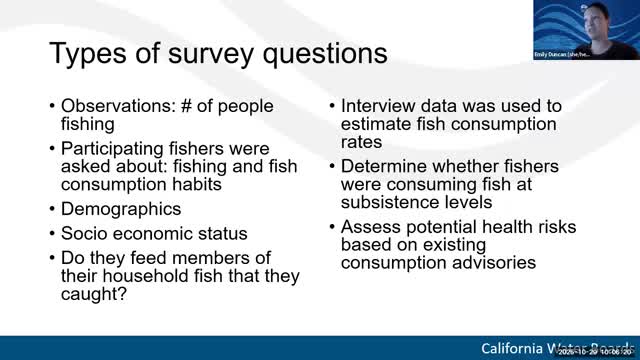LA study: 480 interviews at four urban lakes found roughly 8% of anglers eat their catch; very few meet subsistence thresholds
October 29, 2025 | California Water Quality Monitoring Council, Boards and Commissions, Executive, California
This article was created by AI summarizing key points discussed. AI makes mistakes, so for full details and context, please refer to the video of the full meeting. Please report any errors so we can fix them. Report an error »

LOS ANGELES — A targeted survey of recreational and subsistence anglers at four Los Angeles‑area urban lakes found a small share of fishers regularly ate their catch, and only a handful met the study’s subsistence threshold.
Emily Duncan presented results of the study, conducted January–September 2024 and funded through Region 4 SWAMP and discretionary funds. Interview teams collected observational counts and conducted conversational questionnaires with anglers at four lakes: Peck Road Park Lake, Lehi Lake, Magic Johnson Lake and Alondra Park Lake. A total of 480 unique interviews were completed.
Findings
- About 39 interviewees (roughly 8%) reported consuming fish they caught from the surveyed lakes. Of those, 33 reported consumption at rates below OEHHA advisory levels in effect for those water bodies.
- Four individuals met the study’s subsistence definition (consuming ≥100 grams of caught fish per day). Those four were male, aged roughly 35–70, identified as Asian/Pacific Islander, Hispanic/Latino or multiracial, and reported frequent consumption (mean 616 g/day; median 438 g/day). One interview, conducted in Mandarin, recorded a particularly high reported intake (about 1,459 g/day), which surveyors flagged as an outlier but believed to reflect real heavy use.
- Household consumption matters: three household members (from different households) were reported as subsistence consumers; interview respondents reporting household consumption were often low income (reported household income in the $0–$20,000 band) and had interviews conducted in Mandarin.
- Reasons anglers did not eat their catch included: fishing as a hobby (64%), water‑quality concerns (≈24%), species not preferred for eating (≈24%), small fish (9%) and other reasons (3%). Posted warning signs were correlated with lower self‑reported consumption at sites such as Magic Johnson Lake.
Methods and limitations
Interview teams visited each lake typically twice per month (weekday and weekend) and conducted conversational interviews in multiple languages where needed. Emily said the survey budget was “pretty expensive” — a ballpark of $200,000–$300,000 — due to field effort and multilingual interviewing.
Policy context and next steps
The study was conducted to support basin planning and to help regions assess whether subsistence beneficial use designations are appropriate. Work group members noted the need for a statewide “template” or best‑practice survey for subsistence consumption; Laurie Weber, the Monitoring Council director, and others supported developing guidance and identifying community partners to carry out culturally appropriate surveys.
What officials said
Emily Duncan (presenter): “A small percentage of fishers were regular [consumers]…about 8%.”
The study’s authors and materials will be posted when the report is finalized; the presenter said she will share slides and make the report available on the regional web page when posted.
Emily Duncan presented results of the study, conducted January–September 2024 and funded through Region 4 SWAMP and discretionary funds. Interview teams collected observational counts and conducted conversational questionnaires with anglers at four lakes: Peck Road Park Lake, Lehi Lake, Magic Johnson Lake and Alondra Park Lake. A total of 480 unique interviews were completed.
Findings
- About 39 interviewees (roughly 8%) reported consuming fish they caught from the surveyed lakes. Of those, 33 reported consumption at rates below OEHHA advisory levels in effect for those water bodies.
- Four individuals met the study’s subsistence definition (consuming ≥100 grams of caught fish per day). Those four were male, aged roughly 35–70, identified as Asian/Pacific Islander, Hispanic/Latino or multiracial, and reported frequent consumption (mean 616 g/day; median 438 g/day). One interview, conducted in Mandarin, recorded a particularly high reported intake (about 1,459 g/day), which surveyors flagged as an outlier but believed to reflect real heavy use.
- Household consumption matters: three household members (from different households) were reported as subsistence consumers; interview respondents reporting household consumption were often low income (reported household income in the $0–$20,000 band) and had interviews conducted in Mandarin.
- Reasons anglers did not eat their catch included: fishing as a hobby (64%), water‑quality concerns (≈24%), species not preferred for eating (≈24%), small fish (9%) and other reasons (3%). Posted warning signs were correlated with lower self‑reported consumption at sites such as Magic Johnson Lake.
Methods and limitations
Interview teams visited each lake typically twice per month (weekday and weekend) and conducted conversational interviews in multiple languages where needed. Emily said the survey budget was “pretty expensive” — a ballpark of $200,000–$300,000 — due to field effort and multilingual interviewing.
Policy context and next steps
The study was conducted to support basin planning and to help regions assess whether subsistence beneficial use designations are appropriate. Work group members noted the need for a statewide “template” or best‑practice survey for subsistence consumption; Laurie Weber, the Monitoring Council director, and others supported developing guidance and identifying community partners to carry out culturally appropriate surveys.
What officials said
Emily Duncan (presenter): “A small percentage of fishers were regular [consumers]…about 8%.”
The study’s authors and materials will be posted when the report is finalized; the presenter said she will share slides and make the report available on the regional web page when posted.
Don't Miss a Word: See the Full Meeting!
Go beyond summaries. Unlock every video, transcript, and key insight with a Founder Membership.
✓
Get instant access to full meeting videos
✓
Search and clip any phrase from complete transcripts
✓
Receive AI-powered summaries & custom alerts
✓
Enjoy lifetime, unrestricted access to government data
30-day money-back guarantee

